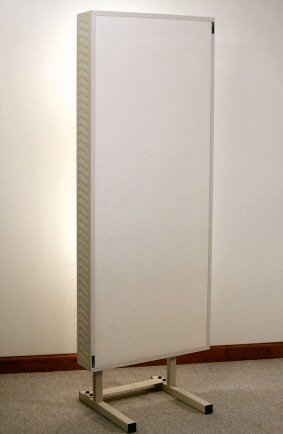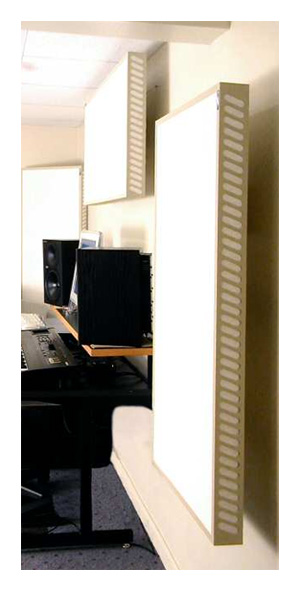You are reading the older HTML site
Positive Feedback
ISSUE
20
july/august
realtraps
MiniTraps and MondoTraps
as reviewed by Danny Kaey

All images courtesy of RealTraps
|
DANNY KAEY'S SYSTEM
LOUDSPEAKERS
ELECTRONICS
SOURCES
CABLES
|
I discovered RealTraps more by coincidence than by design. Late last year, my wife and I had a discussion about rearranging our apartment. The problem was that our media room and audio room (and living room) was the same room, so when I wanted to listen to music, my wife and daughter could not watch the tube, and vice versa. We decided to keep the living room as the audio room and to convert the adjacent dining room to the media room. After spending a weekend moving a tremendous number of our belongings out of the living room, I realized that while I now had a nice big room for my audio system, I also had to deal with some serious acoustic problems. While the room had not been jam-packed, the furniture had been taming the room echoes. Suddenly it was gone! Adding CD and LP racks and other bits of living room furniture improved the situation, but the sound was simply not happening.
Readjusting my Velodyne DD-15 subwoofer for the new room acoustics proved eye opening. One of the features of the DD-15 is its ability to show you a real-time display of your room's lower octaves. You plug in the supplied microphone, connect the sub to a TV monitor, and are given a visual display of your room problems. I had a 10-dB suck-out around 60Hz, a 6-dB hump around 80Hz, and a series of sharp peaks and valleys in the lower mid-bass region. Dialing in the subwoofer, I was able to eliminate the suck-out, but could not rid the room of the nasty 80Hz bump. The bass was washed out and boomy, while the rest of the frequency range sounded diffused and echo-ey. Room treatments were in order.
I had not been lucky with room treatments in the past. While auditioning new loudspeakers the summer before, I had purchased corner treatments that were supposed to dramatically improve the bass, but they simply didn't work as claimed. Then a friend of mine loaned me four very large panels that improved the overall sound, offering more definition and less diffusion, but the bass regions were left untouched. I began to wonder whether it was possible to tame my room. Could I improve the sound without heavily modifying the walls and corners? Several friends in the industry recommended that I try some RealTraps, but without hearing them for myself, I was reluctant to contact the company. A look at the RealTraps www.realtraps.com yielded so much information that I felt I could write a thesis on room treatment! Simple-to-understand graphs, charts, and most importantly, videos, show the benefits of using RealTraps. As it says in the introductory paragraph, "Owning all the high-end gear in the world is useless if your listening room has echoes and standing waves to obscure musical detail and skew the frequency response." I couldn't have said it better myself, and I was experiencing just those problems. The thing that really convinced me was learning that RealTraps were used in many professional studios. An email inquiry to the company yielded a quick and informative response from Ethan Winer, the owner (with business partner Doug Ferrara).
I explained my room problems to Ethan, who offered meaningful advice, and a few weeks later, UPS delivered more RealTraps than I thought would be necessary—four MiniTraps (two 2' x 4' and two 2' x 2'), two high-frequency absorbing MiniTraps HF (2' x 4'), and two MondoTraps (2' x 4' 9"). I was expecting the price tag to be high, but was pleasantly surprised by their cost effectiveness. The MondoTraps are $299, the 2' x 4' MiniTraps $199, and the 2' x 2' MiniTraps $139. Could these solve my problems? Further discussing my room with Ethan, he recommended that I place the two MondoTraps in the corners of the room behind the speakers, flanked by two 2' x 2' MiniTraps. Two 2' x 4' MiniTraps went in the back corners, also flanked by two 2' x 2' MiniTraps, and the two MiniTrap HFs were placed to the side of the speakers, leaning against the wall. RealTraps offers mounting solutions and stands for their products, but I decided to forgo these until I felt that the improvements were definitive.
The panels are offered in three different colors to
match just about any décor, so their intrusion was kept to a minimum. My wife,
who had just come home from a shopping trip, didn't even notice them. Visuals
are one thing, but I was mostly concerned about whether they did what they were
supposed to do. The answer to that came before I had played a single CD—just
walking into the center of the room while talking demonstrated that my voice
sounded much more natural. The echoes were suddenly gone, and the room seemed to
have just the right amount of damping. Eager to experience music, I cued up a
very bass-heavy demo track by Massive Attack. The track had been virtually unlistenable prior to the introduction of the RealTraps, but now it was a source
of bliss. The electronic bass line suddenly came to life, without the nasty boom
I had heard before. The instruments were placed in a well defined
three-dimensional space. When I played Water Lily Acoustics' stunning new Mahler
Fifth recording, the crescendi had such gutwrenching impact that I was taken
aback. I had always felt the power of the Velodyne sub, but I had never heard
the nuances associated with these recordings.
demonstrated that my voice
sounded much more natural. The echoes were suddenly gone, and the room seemed to
have just the right amount of damping. Eager to experience music, I cued up a
very bass-heavy demo track by Massive Attack. The track had been virtually unlistenable prior to the introduction of the RealTraps, but now it was a source
of bliss. The electronic bass line suddenly came to life, without the nasty boom
I had heard before. The instruments were placed in a well defined
three-dimensional space. When I played Water Lily Acoustics' stunning new Mahler
Fifth recording, the crescendi had such gutwrenching impact that I was taken
aback. I had always felt the power of the Velodyne sub, but I had never heard
the nuances associated with these recordings.
Everything seemed to be tied more tightly to the stage. Images that used to float now had razor-sharp focus and solidity. Not only was there more of everything, but there was a connectiveness that I had never heard. The RealTraps improved the sound of my room to a degree that I simply could not have achieved with a component upgrade. Employing the HF (high-frequency) MiniTraps next to my Marten Design Dukes further increased their authority and, most importantly, their imaging, detail retrieval, and soundstaging. I could clearly hear better depth, width, and height on the Ricardo Chailly performance of Ionisation on the London CD Varese: Complete Works. The soundstage had grown to more realistic proportions, without any adverse effect. It was simply huge! I had been told that the RealTraps would give dramatic improvements in bass quality, but I didn't grasp the meaning of that until I heard it in my room.
After installing the RealTraps, I did another room sweep with the Velodyne DD-15. The nasty bump at 80Hz had been dramatically reduced, and the entire bass range above 80Hz had become much smoother. The peaks and valleys were transformed into rolling hills. The introduction of the RealTraps really paid off. I wasn't able to see the effect of the HF MiniTraps through the Velodyne, which only goes up to 200Hz, but the results were easy to hear—removing the HF Traps noticeably shrank the size of the recorded venue. I began to wonder if adding more RealTraps could further improve the sound. I asked Ethan, who said that you want to use as many RealTraps as possible. The downside to that, of course, is the wife acceptance factor.
The RealTraps room treatments work better than any other products I have tried. I venture to say that virtually anyone can more dramatically improve the sound of their system by using RealTraps than by spending thousands of dollars on a CD player, turntable, or amplifier upgrade. To those who advised me to look into the RealTraps, thank you very much for pointing me in the right direction. Danny Kaey
MiniTraps
Retail: $199.99 each
MondoTraps
Retail: $299.99 each
RealTraps
web address:
www.realtraps.com
